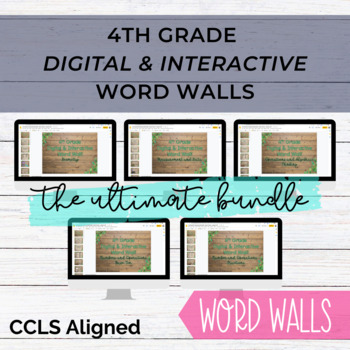BUNDLE - 4th Grade Digital and Interactive Word Wall for Google Slides
- Zip
- Google Apps™

Products in this Bundle (5)
Description
This interactive word wall bundle is perfect for distance learning and can be used as decor in your farmhouse themed classroom! The bundle includes
- 4.NBT Standards
- 4.NF Standards
- 4.OA Standards
- 4.MD Standards
- 4.G Standards
This bundle will include all 5 strands of the CCLS when it's complete! Grab it now while the price is cheaper!
Each product in the bundle includes:
- A PDF version of the words with the Frayer model.
- A Table of Contents that is interactive on Google Slides for students.
- Teacher and Student directions.
- Instructions and ideas for printing the word wall.
Not sure exactly how to use the Google Slides version? Check out this blog post about using Google Slides.
https://techaboutmath.com/fivethingsgoogleslides/
Please consider leaving feedback for this product! It means so much to me, and it helps you earn FREE products! For every review you leave, you earn 1 credit point toward a future purchase. Go to "My Purchases" to leave a review & thank you in advance!
If you hit the green FOLLOW ME button, you will get:
-Updates when new products are released
-Notifications when I have a sale
Connect with me:
Check out my blog to see the latest tips and tricks on integrating tech into your classroom! (and grab some freebies while you’re at it!)
For all my latest teaching ideas, books to read and Cricut stuff:
If you want to see pictures of my cute dog and catch monthly math chats:
Check out the AMAZING Facebook group for tech tips and tricks for distance learning!
Facebook Group for Distance Learning Tips and Tricks
Questions? E-mail me at alexandra@techaboutmath.com


